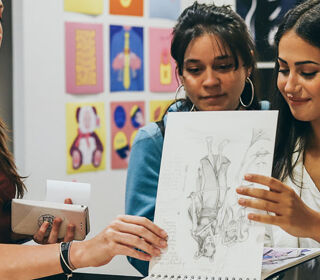
Blog

As a creative individual with a flare for drawing or design, you might be torn between studying graphic design, Product Design or illustration. We’ve broken down the two subjects so you can make the right choice for you.
Designers play an important role in society and have the ability to make meaningful change to our world. You will be encouraged to develop a critical eye through briefs that challenge you to go beyond the surface, providing sustainable and culturally-conscious solutions to real-world issues.
What is Graphic Design?
Graphic design is a broad and dynamic sector that encompasses a wide range of creative activities. From creating packaging designs and posters to designing the layouts of magazines, brochures, and reports, graphic design is about crafting visual content that communicates effectively with an audience.
Our Graphic Design course delves deep into both traditional and contemporary design practices. You'll explore areas such as typography, branding, and user experience (UX) design, equipping you with the skills to work across various media platforms.
The course emphasises hands-on experience, and you'll have the opportunity to work on live projects with real clients, giving you a taste of the professional world while still in school.
Find out about Yasmina's time as a Graphic Design student at BCU.
What is Product Design?
Product Design focuses on the creation and development of creative, contemporary, and innovative products and furniture, considering user-centred design, sustainability, social context, and commercial understanding. From ideas to production, you will be equipped with specialist knowledge and skills to help you design and develop products that address real-world challenges and enhance user experience.
Throughout your degree, you will be encouraged to explore materials, techniques, and processes, from one-off bespoke design to standardised mass production. You will learn a range of research and design methods alongside continual practical skills development. Live student projects take place throughout the course to enhance your employability, communication skills, and professional practice.
Student Amelia gave us an insight into what a day in the life studying Product Design is like.
What is Illustration?
Illustration is the art of creating drawings and artwork that often accompany other media, such as books, magazines, and websites. Illustrators use their creative skills to bring stories, ideas, and messages to life through visual representation. This field is not just about drawing; it’s about conveying emotion, narrative, and meaning through imagery.
Our Illustration course encourages you to develop a personal visual language, whether your work is narrative-driven or conceptual. The course covers a wide range of techniques, from traditional drawing and painting to digital illustration and animation. You'll also learn about the business side of illustration, preparing you for a career as a freelance illustrator or working within a creative team.
It's important to note that illustration uses more mediums than just the traditional method drawing you may think of. Many illustrators use digital methods as well as painting and other formats.
Find out about Abbie Severn's Illustration journey at BCU.
Skillsets
These subjects intertwine with each other; all subjects share a strong foundation in visual communication, but apply their skills in different ways.
As an illustrator, your focus might be on bringing words or emotions to life through your artwork. A typical example would be illustrating a book cover or creating visuals for a children’s book. If you excel at drawing and enjoy the idea of creating art that reinforces a particular message, illustration might be the path for you. Our Illustration course places a strong emphasis on developing your unique style and voice, encouraging experimentation with different media and techniques.
A product designer might need more physical skills, such as woodworking or clay modelling, to create or prototype their designs. The course develops skills and experience in and around the subject of scales of manufacture, from bespoke, one-off and batch production to standardised mass production.
On the other hand, a graphic designer is skilled in visualising layouts, understanding the importance of placement, color psychology, and typography. Graphic designers often undertake market research to inform their creative practice, ensuring that their designs are not only visually appealing but also strategically effective. The Graphic Design course modules cover everything from branding and identity to editorial design and UX/UI design.
Which course is right for me?
Still unsure? Have a go at the below quiz to find out which course suits you best.